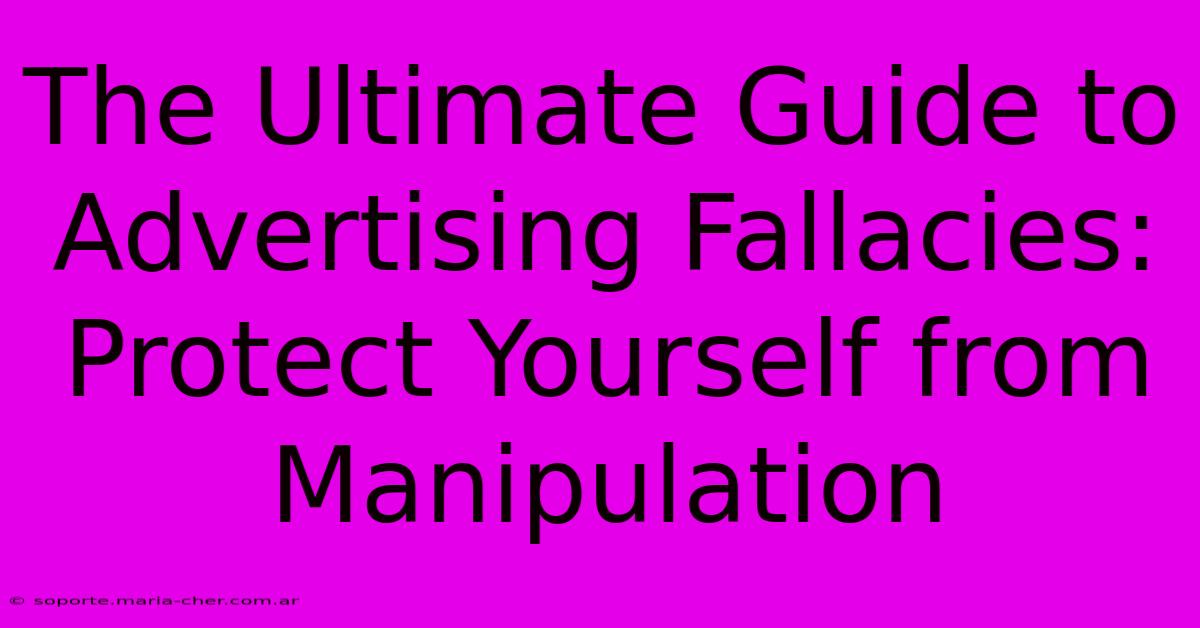The Ultimate Guide To Advertising Fallacies: Protect Yourself From Manipulation

Table of Contents
The Ultimate Guide to Advertising Fallacies: Protect Yourself from Manipulation
In today's saturated media landscape, we're bombarded with advertisements – from catchy jingles to emotionally charged images. But how much of what we see is actually true? More importantly, how can we protect ourselves from manipulative advertising techniques? This guide delves into the common fallacies advertisers employ and equips you with the critical thinking skills to navigate the world of marketing with confidence.
Understanding Advertising Fallacies
Advertising fallacies are deceptive arguments used to persuade consumers without providing sound reasoning. They exploit psychological biases and cognitive shortcuts, making them incredibly effective, even when logically flawed. Recognizing these tactics is the first step towards becoming a savvy consumer.
1. Bandwagon Effect: "Everyone's Doing It!"
This fallacy preys on our innate desire for belonging. Advertisements using the bandwagon effect suggest that a product's popularity equates to its quality or desirability. Example: "Join millions of satisfied customers!" While popularity can be an indicator, it's not a guarantee of quality.
2. Testimonial: "I Used It and It Worked Wonders!"
Testimonials leverage the power of personal experience. However, these testimonials are often selectively chosen, and the positive results might not be representative of the average user experience. Example: Celebrity endorsements or user reviews without proper verification. Always look for reviews from multiple sources, not just those presented by the advertiser.
3. Appeal to Authority: "Experts Agree..."
This fallacy uses the perceived authority of a person or institution to validate a claim. However, the authority figure may not be an expert in the relevant field, or their endorsement might be paid. Example: A doctor endorsing a weight-loss supplement without sufficient scientific backing. Verify the credibility and expertise of the authority cited.
4. Plain Folks: "Just Like You and Me..."
This tactic aims to create a sense of relatability. Advertisers portray themselves or their products as ordinary and relatable, implying shared values. Example: A CEO shown working alongside their employees. Be critical of this approach; relatability doesn't guarantee product quality.
5. Appeal to Emotion: "Tug at Your Heartstrings..."
Emotionally charged advertisements bypass logic, using fear, sadness, joy, or patriotism to manipulate consumers. Example: Heart-wrenching images used to sell a charity donation. While emotions are valid, ensure the product’s merit stands independently from its emotional appeal.
6. Glittering Generalities: "The Best, The Greatest, The Only..."
This fallacy uses vague, positive terms without concrete evidence. It often employs superlatives and subjective claims without substantiation. Example: "Our product is the most innovative on the market!" Look for specific details and evidence to support such claims.
7. False Dilemma: "Either/Or"
This fallacy presents only two options, often one favorable to the product being advertised, ignoring other possibilities. Example: "Choose our product or suffer the consequences." Always consider alternative choices and weigh them objectively.
8. Red Herring: "Distraction Tactics..."
This technique diverts attention from the product's shortcomings by focusing on irrelevant aspects. Example: An advertisement highlighting a product’s stylish design while ignoring its poor functionality. Stay focused on the product's core features and functionality.
9. Slippery Slope: "One Step Leads to Ruin..."
This fallacy implies a series of negative consequences stemming from a single action, often exaggerated or unlikely. Example: "If you don't use our product, your skin will age prematurely." Analyze the claim for logical connections and avoid irrational fear-mongering.
Protecting Yourself from Manipulation
Learning to identify these fallacies is crucial. Here are some practical tips to safeguard yourself:
- Question everything: Don't accept claims at face value.
- Look for evidence: Demand concrete proof to support any claims.
- Check multiple sources: Don't rely solely on one advertisement.
- Read the fine print: Pay close attention to details and disclaimers.
- Consider your emotional response: Are your emotions influencing your decisions?
- Compare products: Don't settle for the first option you see.
By developing a critical eye and employing these strategies, you can effectively navigate the world of advertising and make informed purchasing decisions, free from manipulative tactics. Becoming a more informed consumer empowers you to make choices based on logic and reason, not deceptive advertising techniques.

Thank you for visiting our website wich cover about The Ultimate Guide To Advertising Fallacies: Protect Yourself From Manipulation. We hope the information provided has been useful to you. Feel free to contact us if you have any questions or need further assistance. See you next time and dont miss to bookmark.
Featured Posts
-
Unbelievable Fake Ads Exposed Your Jaw Will Drop
Feb 07, 2025
-
Uncover The Sneaky Tactics How Advertisers Manipulate Your Mind With Fallacies
Feb 07, 2025
-
Transform Your Designs With The Cutting Edge Futura Now Trial
Feb 07, 2025
-
Calling All Disney Lovers The Ultimate Guide To The Enchanted Realm Awaits
Feb 07, 2025
-
A Floral Bargain Find Out How Little A Bouquet Of Baby Breath Costs
Feb 07, 2025
